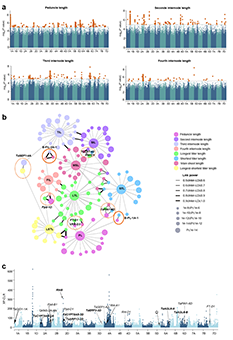Genetic basis of geographical differentiation and breeding selection for wheat plant architecture traits

GWAS and network analysis of tiller height across a panel of wheat accessions.
In a new study recently published in Genome Biology, titled "Genetic basis of geographical differentiation and breeding selection for wheat plant architecture traits," the research team led by professor Zifeng Guo from the Key Laboratory of Plant Molecular Physiology, Chinese Academy of Sciences had made great progress in the genetic basis of wheat plant architecture.
Using 306 worldwide wheat accessions (40 million reliable SNPs obtained by resequencing) including both landraces and traditional varieties, we conduct a genome-wide association study (GWAS) to dissect the genetic basis of geographical differentiation of these traits. We determine the changes of haplotypes for the associated genomic regions in frequency in 831 wheat accessions that are either introduced from other countries or developed in China from last two decades. We identify 83 loci that are associated with one trait, while the remaining 247 loci are pleiotropic. We also find 163 associated loci are under strong selective sweep. GWAS results demonstrate independent regulation of internode length of individual stems and consistent regulation of tiller length of individual plants. This makes it possible to obtain ideal haplotype combinations of the length of four internodes. We also find that the geographical distribution of the haplotypes explains the observed differences in internode length among the worldwide wheat accessions. This study provides insights into the genetic basis of plant architecture. It will facilitate gene functional analysis and molecular design of plant architecture for breeding.
Article link: https://genomebiology.biomedcentral.com/articles/10.1186/s13059-023-02932-x